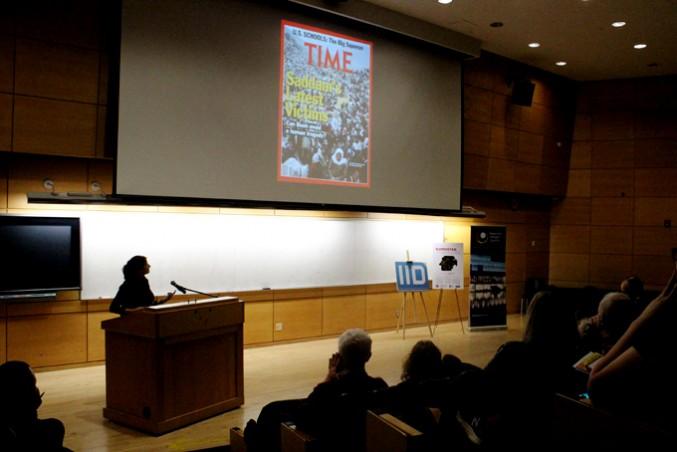By Stefanie Phillips
Sitting in the crowd of a lecture hall in the George Vari Engineering and Computing Centre, Chro Zand teared up after seeing a photo of her mother and two brothers in Kurdistan. Susan Meiselas, an established documentary photographer, visited campus to present her series of war photographs in a lecture on Wednesday night, she opened the floor to questions and that was when Zand revealed her connection to the photo collection.
“Thank you Susan for taking me back to my home,” Zand said in front of the full lecture hall. “I was one of the people who was in the uprising in 1991 and I came here [to Canada] and [tonight] you took me back to my past, my home. And the suffering and pain that I went through. I’m wondering what makes you search for the history for the people who are not recognized [because] we are not recognized as a country?”
Meiselas spoke about her novel Kurdistan: In the Shadow of History, which archives the struggle of the Kurdish population and their fight for survival and independence in the 20th century through photographs. The lecture was organized by Ryerson’s Image Centre and the International Issues Discussion Series.
She led the crowd through the six years which she spent collecting photographs and gathering documents that would eventually make up a hundred year curated history of Kurdistan – a country that has remained without a homeland or a national archive since 1918.
“In making this object, a book, I kind of had a sense there was a family album in a certain way, a family that was very dispersed and fractured and through fragments could maybe see itself being seen.” Meiselas said. “Even if it sometimes wasn’t how they wanted to be seen or remembered.”
When Meiselas started the project in 1991, all she knew was that 4,000 Kurdish villages were destroyed in a part Northern Iraq, populated by Kurds, and that there was an ongoing campaign to “annihilate” them. As a Magnum photographer and a nomad, she decided to travel to that part of Iraq and find out more.
“What I was seeing were piles of rubble on hillsides that had formally been villages,” she said. “Until I got to a place called Qaladiza which was the home for 70, 000 people and it had been systematically destroyed, house by house.”
Part of her work was discovering that people were living underneath the rubble in fear of being exiled to Turkey or Iran. Something she says wouldn’t surprise her if it were happening today in Syria. She showed the crowd a picture of the fallen houses that looked like a demolition site purposely left behind by a builder.
After meeting and speaking to the people there, her project shifted from taking photographs to gathering them, and she set out with the goal of making a visual history of a group of people who were “barely” known to the world at the time. The idea was to create an “imagined community of Kurdistan.”
“I think the idea you can see from this is the notion of a mosaic. Up close you can see all the gaps, but from far away you can see the bigger picture,” she said.
What Meiselas and her assistant found during their journey was enough to sketch the history of a century that could be seen in her book, on the website akaKurdistan, which she launched, and in the travelling gallery.
Even though you can’t find Kurdistan on any map today, there are still more than 20 million Kurds dispersed throughout Syria, Turkey, Iran, Iraq and many more countries around the world — they are the largest group of people living without a state in the world.
The website has been taken down because of mass hacks, but the book still lives on. Meiselas said one of the “great pleasures” of her long lifetime of travelling was bringing the book back to the very places she gathered the photos, in 2007.
“The first thing I [did] is go back to Qaladiza, and [I] see that it’s beginning to be rebuilt.” She recalls. “And of course we are seeing this region fragment again.”
At the end of the lecture, Meiselas donated a copy of her book to the Ryerson Image Centre to be displayed, where the many Kurds in the audience and other people interested can go and see the project for themselves.










Devilsfruit
There are mistakes in this article.
”they are the largest group of people living without a state in the world.”
A simple Google search would tell you that:
The Tamil people with 77 million are the largest group of people living without a state in the world.
The Yoruba people with 35 million are the second largest. And the Igbo people with the Kurdish people are on a shared third place with 30 million people.
You’re welcome.